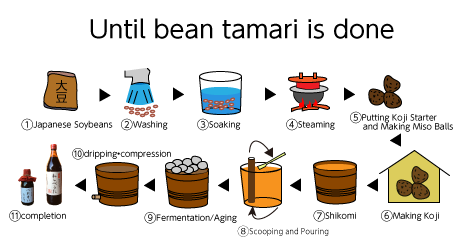Tamari
At “Minamigura” we start production by putting 1.5 tons of soybeans in a huge wooden vat with half the amount of water; this is called “Gobujicomi”. In more industrial production equal amounts of water are used, this “Tomizujikomi” it has a much weaker flavor. For “Gobujikomi”, the soybeans and water are aged for three years. This “Tamari” is fermented, naturally aged for a long time and has a special flavor, and it is entirely natural.
The role of “Koji” in making “Tamari” is as important as it is for Miso (but the type of Koji fungus is different). We collect the very rich and ripe tasting “Tamari” that drops little by little from the vat after aging for three years. This “Tamari” is called “Kibikidamari”. Alternatively we take the Miso out of the vat and put it between cloths and press it. This “Tamari” is called “Assakudamari”.
Large companies use a combination of wheat and soybeans in mass production because wheat fungus ferments soybeans much faster than the natural soybean fungus. However, only good soybeans, grown in Japan, natural salt and pure water are used at “Minamigura”.

